Top 10 Unique Japanese Foods You Must Try in Japan
(Weird but Delicious!)
Japan has one of the most exciting food cultures in the world. While sushi and ramen are famous globally, there are many unique Japanese dishes that might surprise first-time visitors. From fermented foods to raw delicacies, these 10 dishes may seem unusual but are definitely worth trying!
- 1. Natto (Fermented Soybeans) – The Slimy Superfood
- 2. Fugu (Pufferfish) – The Deadly Delicacy
- 3. Basashi (Raw Horse Meat) – The Japanese Sashimi Surprise
- 4. Shirako (Fish Sperm) – The Ultimate Umami
- 5. Kujira (Whale Meat) – A Controversial Japanese Dish
- 6. Hoya (Sea Pineapple) – The Ocean’s Strange Gift
- 7. Inago no Tsukudani (Soy-Glazed Grasshoppers) – The Crunchy Snack
- 8. Torisashi (Raw Chicken Sashimi) – The Brave Foodie’s Choice
- 9. Umeboshi (Pickled Plums) – The Sour Bomb
- 10. Kusaya (Fermented Fish) – The Smelliest Food in Japan?
- Bonus: Useful Japanese Phrases for Food Lovers
- Final Thoughts
1. Natto (Fermented Soybeans) – The Slimy Superfood
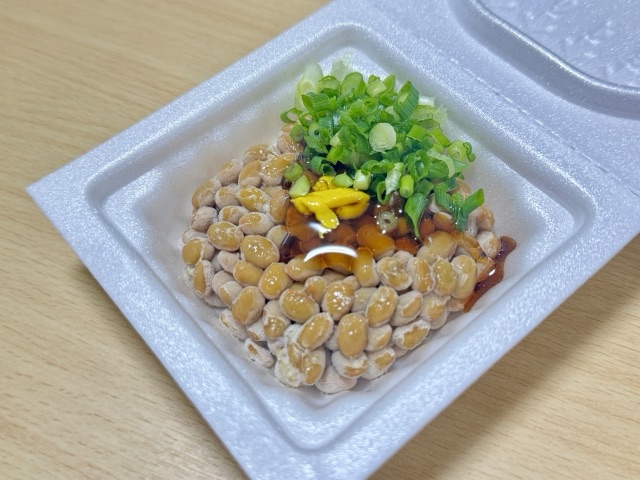
Taste & Texture: Sticky, slimy, strong umami flavor
How to Eat: Mixed with rice, soy sauce, and mustard
Best Place to Try: Traditional breakfast restaurants, supermarkets
Natto is made by fermenting soybeans with Bacillus subtilis bacteria, creating its distinct sticky texture and pungent smell. The flavor is rich in umami, with a slightly bitter and nutty aftertaste.
It’s commonly eaten at breakfast, mixed with soy sauce, mustard, and chopped green onions, and served over warm rice. Some people add raw egg for extra creaminess.
While natto has a strong smell and gooey texture, it’s incredibly healthy, packed with probiotics, vitamin K, and protein.
Tip: If you’re trying natto for the first time, start with a smaller portion mixed with plenty of rice to balance the flavor.
2. Fugu (Pufferfish) – The Deadly Delicacy
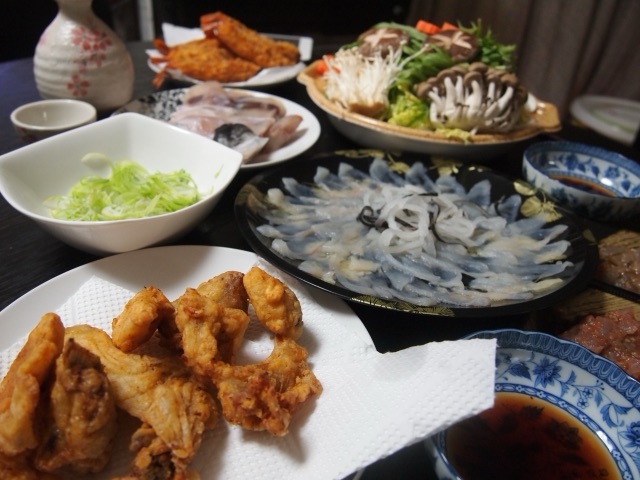
Taste & Texture: Mild, slightly chewy, delicate sweetness
How to Eat: Raw as sashimi, deep-fried, or in hot pot
Best Place to Try: Licensed fugu restaurants (Tokyo, Osaka)
Fugu (pufferfish) is famous for its potentially lethal poison, making it one of the most thrilling dishes to try in Japan. Only licensed chefs can prepare it, ensuring that it’s completely safe to eat.
The most popular way to enjoy fugu is as fugu sashimi (tessa)—thinly sliced raw fish arranged beautifully on a plate. It has a slightly chewy texture and a mild, subtle sweetness.
Other delicious fugu dishes include:
• Fugu karaage – Deep-fried pufferfish, crispy outside and tender inside.
• Fugu nabe (hot pot) – Cooked with vegetables and tofu in a flavorful broth.
Fun Fact: Fugu’s poison (tetrodotoxin) is 1,200 times more toxic than cyanide, but properly prepared fugu is completely safe!
Want to learn more about fugu safety? Read our related article: Is Fugu Deadly? Understanding the Safety of Eating Pufferfish in Japan .
3. Basashi (Raw Horse Meat) – The Japanese Sashimi Surprise
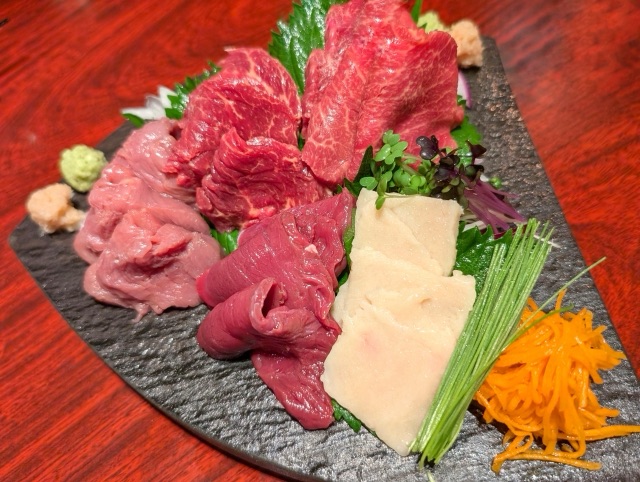
Taste & Texture: Tender, slightly sweet, similar to beef sashimi
How to Eat: Raw with soy sauce, garlic, and wasabi
Best Place to Try: Izakayas in Kumamoto Prefecture
Basashi, or horse meat sashimi, is a delicacy mainly found in Kyushu (southern Japan), especially in Kumamoto. It’s served thinly sliced, chilled, and dipped in soy sauce with garlic or wasabi.
Unlike beef, basashi is leaner and has a slightly sweet flavor. It’s known for being rich in protein and low in fat, making it a favorite among those who enjoy raw meats like beef carpaccio.
Recommended Pairing: Basashi goes perfectly with shochu, a Japanese distilled liquor popular in Kyushu.
4. Shirako (Fish Sperm) – The Ultimate Umami
Taste & Texture: Creamy, soft, slightly sweet seafood flavor
How to Eat: Raw, grilled, or in a hot pot
Best Place to Try: High-end sushi restaurants and izakayas
Shirako means “white children” in Japanese and refers to fish sperm sacs, usually from cod. While it may sound unusual, it’s a luxury delicacy in Japan.
Shirako has a smooth, creamy texture and a mild, slightly sweet taste. It can be enjoyed in different ways:
• Raw (sashimi-style) – Silky and delicate, often served with ponzu sauce.
• Grilled – Lightly charred, giving it a rich umami taste.
• Hot pot (shirako nabe) – Cooked in a broth with vegetables for a warm, comforting dish.
Tip: If you enjoy foie gras or creamy seafood dishes, you might like shirako!
5. Kujira (Whale Meat) – A Controversial Japanese Dish

Taste & Texture: Similar to lean beef or tuna, slightly gamey
How to Eat: As sashimi, deep-fried, or in stews
Best Place to Try: Traditional izakayas and seafood markets
Whale meat has been eaten in Japan for centuries, especially after World War II when it was an important protein source. Today, it’s a controversial dish, but still available in some regions.
Kujira can be enjoyed in several ways:
• Kujira sashimi – Thinly sliced raw whale meat with soy sauce and wasabi.
• Kujira katsu – Breaded and deep-fried whale cutlets, similar to tonkatsu.
• Kujira stew – Slow-cooked with vegetables for a rich, hearty dish.
The taste varies depending on the cut; some parts resemble lean beef, while others have a more fishy, gamey flavor.
Tip: If you want to try kujira, visit a specialty izakaya where it’s prepared with care.
6. Hoya (Sea Pineapple) – The Ocean’s Strange Gift
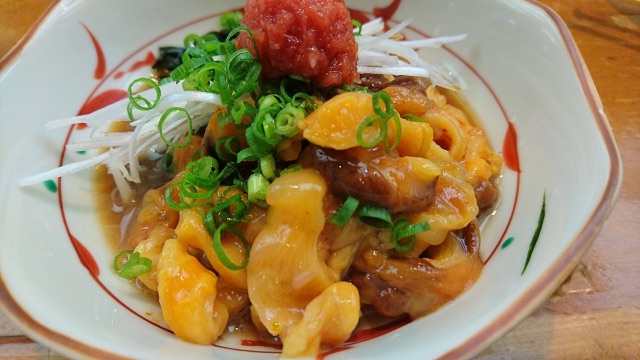
Taste & Texture: Strong briny flavor, slightly chewy
How to Eat: Raw with vinegar or in seafood bowls
Best Place to Try: Miyagi Prefecture, seafood markets
Hoya, also known as sea pineapple, is a bizarre-looking marine creature with a tough, spiky exterior. Inside, the flesh is orange and has a strong, briny, almost metallic taste that divides opinions.
It’s usually eaten raw with vinegar or served on top of kaisen-don (seafood rice bowls). Some describe the taste as a mix of ocean water, iodine, and umami, making it a unique experience.
Fun Fact: Hoya is rich in taurine, which is believed to help reduce fatigue and boost energy.
7. Inago no Tsukudani (Soy-Glazed Grasshoppers) – The Crunchy Snack
Taste & Texture: Crunchy, sweet, and salty
How to Eat: As a snack or rice topping
Best Place to Try: Rural areas and specialty food shops
Inago are small grasshoppers cooked in a sweet soy sauce glaze. This dish was traditionally eaten in mountainous regions, where seafood was scarce.
The flavor is similar to teriyaki sauce, and the texture is crispy and slightly chewy. It’s often eaten as a snack with sake or sprinkled over rice.
Tip: If you can handle shrimp shells, you’ll find inago surprisingly enjoyable!
8. Torisashi (Raw Chicken Sashimi) – The Brave Foodie’s Choice
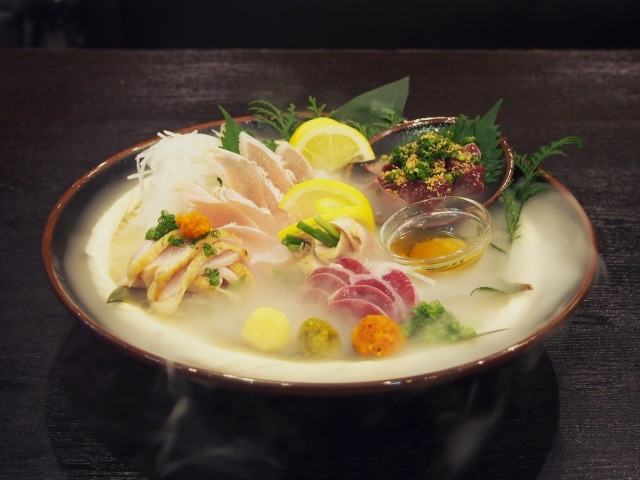
Taste & Texture: Soft, mild flavor, slightly chewy
How to Eat: Sliced raw with soy sauce and wasabi
Best Place to Try: Yakitori restaurants in Kyushu
Torisashi is raw chicken sashimi, carefully prepared to be safe to eat. The breast meat is the most common cut, as it has a soft texture and a mild taste similar to raw fish.
It’s typically served chilled, with soy sauce, wasabi, and thinly sliced onions. Some restaurants also serve it lightly seared (tataki style) for extra flavor.
Safety Note: Only eat torisashi at high-quality restaurants where the meat is specially sourced and handled properly.
9. Umeboshi (Pickled Plums) – The Sour Bomb
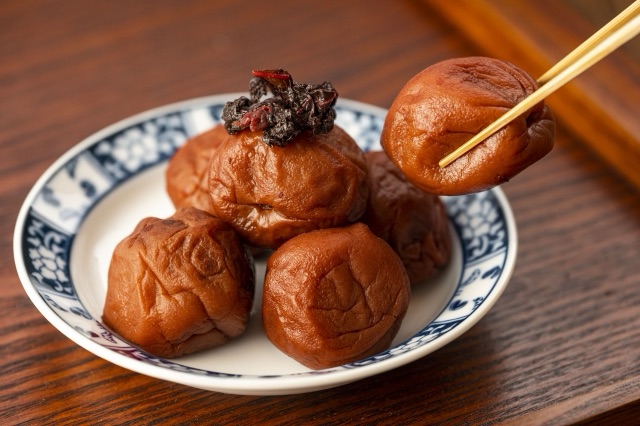
Taste & Texture: Extremely sour and salty, soft texture
How to Eat: With rice, in onigiri, or as a snack
Best Place to Try: Any supermarket or traditional Japanese restaurant
Umeboshi are pickled plums known for their extreme sourness and saltiness. They are often eaten with white rice to balance the flavor.
Popular ways to enjoy umeboshi:
• Onigiri (rice balls) – Stuffed inside rice balls for a tangy kick.
• Ochazuke – Mixed with rice and hot tea for a light meal.
• Straight up! – If you can handle the intense sourness, try eating one on its own.
Tip: Umeboshi is believed to help with digestion and fatigue, making it a common remedy for hangovers.
10. Kusaya (Fermented Fish) – The Smelliest Food in Japan?
Taste & Texture: Extremely strong smell, salty and umami-rich taste
How to Eat: Grilled and eaten with sake
Best Place to Try: Izu Islands or specialty izakayas
Kusaya is a fermented dried fish that has an overpowering smell, often compared to old cheese or sweaty socks. Despite the odor, the taste is surprisingly mild, with a deep umami flavor.
It’s typically grilled and eaten with rice or sake, making it a popular snack in traditional izakayas.
Fun Fact: Kusaya’s strong smell comes from its unique fermentation process, which can last for days.
Bonus: Useful Japanese Phrases for Food Lovers
If you’re planning to try these unique dishes, here are some useful Japanese phrases to help you out!
| Japanese | Romaji | English Meaning |
|---|---|---|
| これは何ですか? | Kore wa nan desu ka? | What is this? |
| ちょっと試してみたいです。 | Chotto tameshite mitai desu. | I’d like to try a little. |
| おすすめは何ですか? | Osusume wa nan desu ka? | What do you recommend? |
| 苦手な食べ物は○○です。 | Nigate na tabemono wa ○○ desu. | I’m not good with (food name). |
| もう少しください。 | Mou sukoshi kudasai. | Please give me a little more. |
Final Thoughts
Japan offers an incredible variety of unique foods that challenge expectations. While some may seem unusual, they each have a rich history and cultural significance.
Would you dare to try fermented fish, raw chicken, or grasshoppers?
Let us know in the comments which dish you’d like to try first!



Comment